How Well Do You Know New York City's Scenic Landmarks?
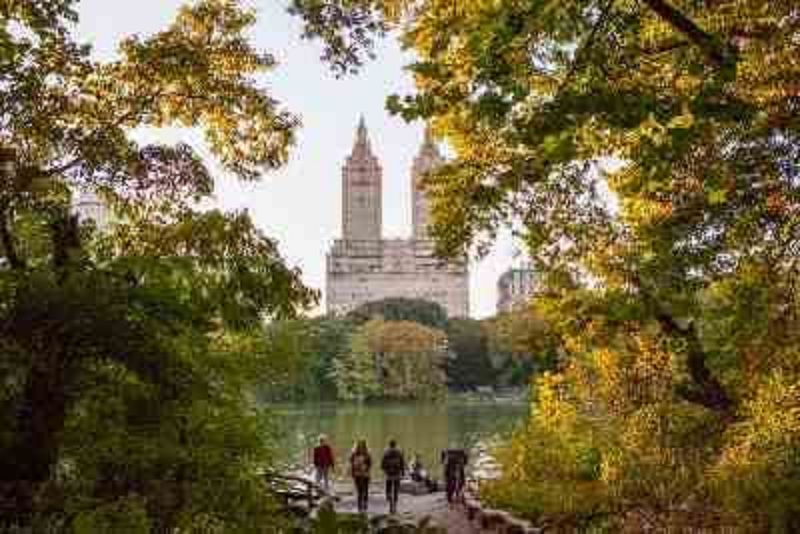
How well do you know New York City's eleven scenic landmarks? Scenic landmarks are city-owned parks or other landscape features that are at least 30 years old and help make our city special. Take this quiz to find out!
Image via Christopher Postlewaite/NYC & Company, NYC Mayor's Office
How well do you know New York City's eleven scenic landmarks? Scenic landmarks are city-owned parks or other landscape features that are at least 30 years old and help make our city special. Take this quiz to find out!
Image via Christopher Postlewaite/NYC & Company, NYC Mayor's Office
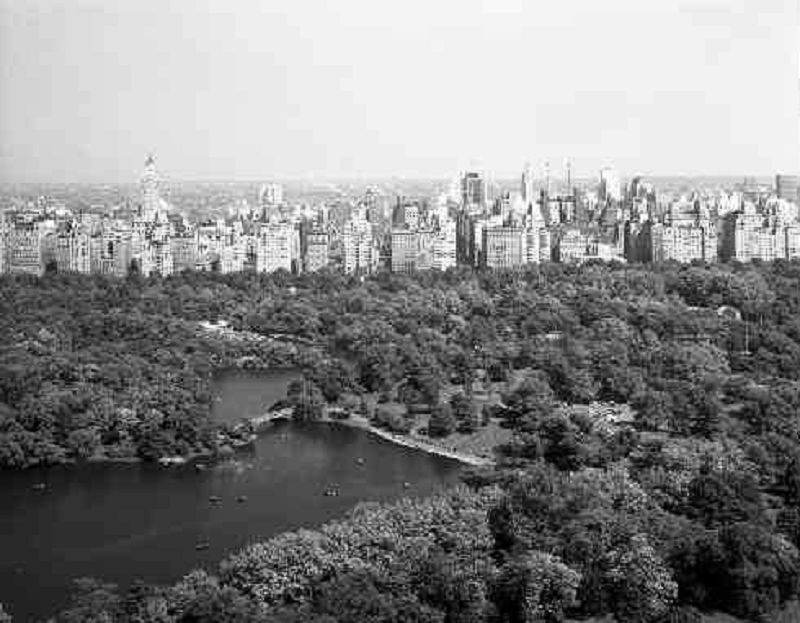
What park, the first planned, large-scale public park in the nation, was New York City's first scenic landmark?
Image via LPC
Bryant Park
Prospect Park
Central Park
Ocean Parkway

Central Park was New York City’s first scenic landmark, designated in April 1974. In the 1840s, as the city’s population increased rapidly and the pressures of an overcrowded urban community became increasingly problematic, a campaign was initiated to create a public green space that would be accessible to all New Yorkers. Frederick Law Olmsted and Calvert Vaux won the competition to design the park, and construction started in 1857. Both men became so invested in the creation of the park that they moved their families into a building at the park’s northern end. The result was a dynamic combination of natural and manmade features, including mounds, swales and lakes, and rock formations interspersed with picturesque pathways, bridges, and buildings.
Image via MCNY
Central Park was New York City’s first scenic landmark, designated in April 1974. In the 1840s, as the city’s population increased rapidly and the pressures of an overcrowded urban community became increasingly problematic, a campaign was initiated to create a public green space that would be accessible to all New Yorkers. Frederick Law Olmsted and Calvert Vaux won the competition to design the park, and construction started in 1857. Both men became so invested in the creation of the park that they moved their families into a building at the park’s northern end. The result was a dynamic combination of natural and manmade features, including mounds, swales and lakes, and rock formations interspersed with picturesque pathways, bridges, and buildings.
Image via MCNY
Which scenic landmark offers stunning views from an iconic promenade that since 1923 has provided open access and drawn people of all ages and economic and social backgrounds to enjoy the seaside?
Ocean Parkway
Riverside Drive and Riverside Park
Morningside Park
Coney Island (Riegelmann) Boardwalk

Named for Borough President Edward Riegelmann, the Coney Island Boardwalk stretches 2. 7 miles, from 37th Street in Coney Island to Brighton 15th Street in Brighton Beach. En route, sun-washed promenaders pass the Cyclone (1927), Parachute Jump (1939), and Wonder Wheel (1918-20), all individual landmarks.
Did you know the boardwalk opened in 1923 and was designed by engineer Philip P. Farley, who later worked on the Brooklyn Heights promenade?
Image via MCNY
Named for Borough President Edward Riegelmann, the Coney Island Boardwalk stretches 2. 7 miles, from 37th Street in Coney Island to Brighton 15th Street in Brighton Beach. En route, sun-washed promenaders pass the Cyclone (1927), Parachute Jump (1939), and Wonder Wheel (1918-20), all individual landmarks.
Did you know the boardwalk opened in 1923 and was designed by engineer Philip P. Farley, who later worked on the Brooklyn Heights promenade?
Image via MCNY
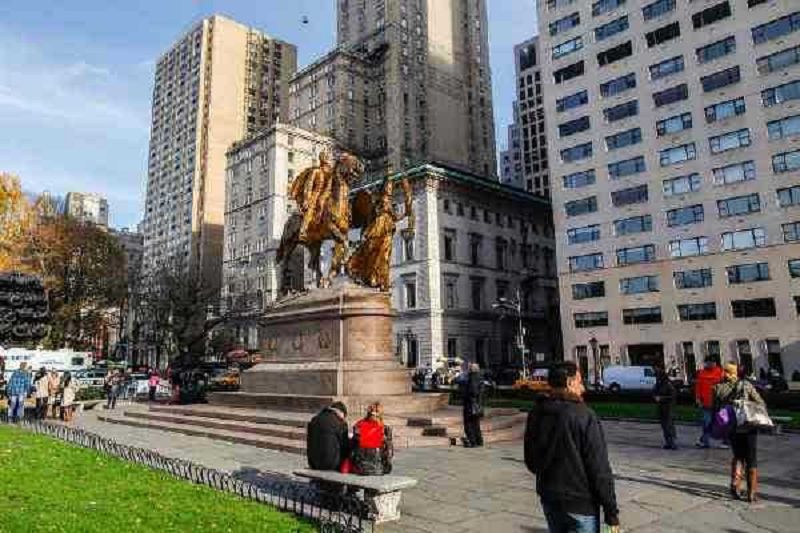
There are two Grand Army Plazas in New York City – one is included within the boundaries of the Prospect Park scenic landmark in Brooklyn, and the other is a scenic landmark located in Manhattan southeast of the Central Park scenic landmark. Who designed Grand Army Plaza in Manhattan?
Hint: It is also the designer of the New York Public Library 20 blocks to the south.
Image of Grand Army Plaza, Manhattan via NYC Go
Henry J. Hardenbergh
Calvert Vaux
Carrere and Hastings
Richard Morris Hunt
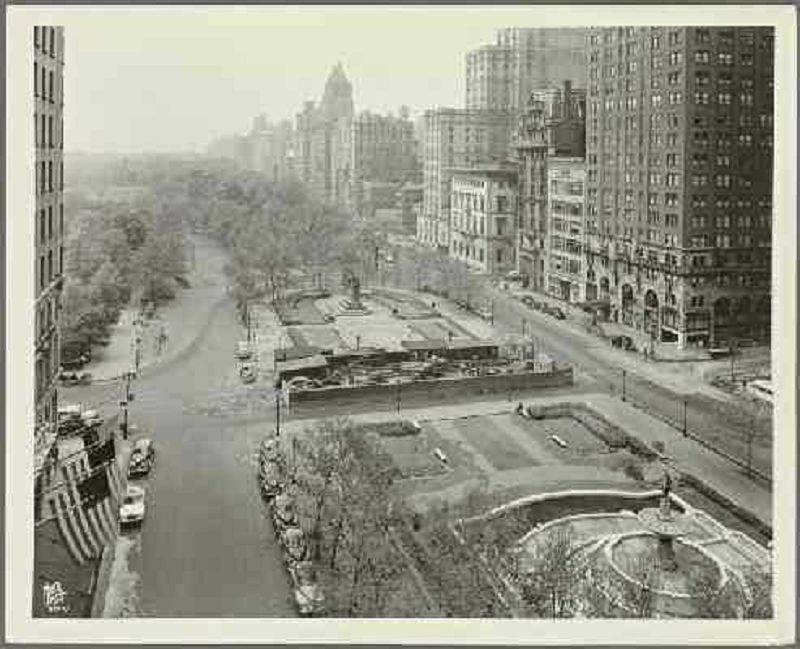
Grand Army Plaza in Manhattan, located between 58th and 60th streets at Fifth Avenue, was designed by Carrere & Hastings between 1913 and 1916. Their plan was heavily influenced by the City Beautiful movement, which emphasized the correlation between the order and aesthetics of a city and the welfare of its residents. Designated as a scenic landmark in 1974, Grand Army Plaza incorporates a fountain sponsored by the newspaper mogul Joseph Pulitzer with a statue by Karl Bitter, as well as a sculpture of General William Tecumseh Sherman by Augustus Saint-Gaudens.
Image of Manhattan's Grand Army Plaza via NYPL Digital Collections
Grand Army Plaza in Manhattan, located between 58th and 60th streets at Fifth Avenue, was designed by Carrere & Hastings between 1913 and 1916. Their plan was heavily influenced by the City Beautiful movement, which emphasized the correlation between the order and aesthetics of a city and the welfare of its residents. Designated as a scenic landmark in 1974, Grand Army Plaza incorporates a fountain sponsored by the newspaper mogul Joseph Pulitzer with a statue by Karl Bitter, as well as a sculpture of General William Tecumseh Sherman by Augustus Saint-Gaudens.
Image of Manhattan's Grand Army Plaza via NYPL Digital Collections

Situated next to the New York Public Library, what park was designated a scenic landmark in 1974 and includes a monument to social worker and reformer Josephine Lowell Shaw, making her the first woman honored by a major monument in New York City?
Hint: The park is also known for another monument, to the poet for whom it is named.
Image via Wikimedia Commons
Tompkins Square Park
Bryant Park
Morningside Park
Madison Square Park
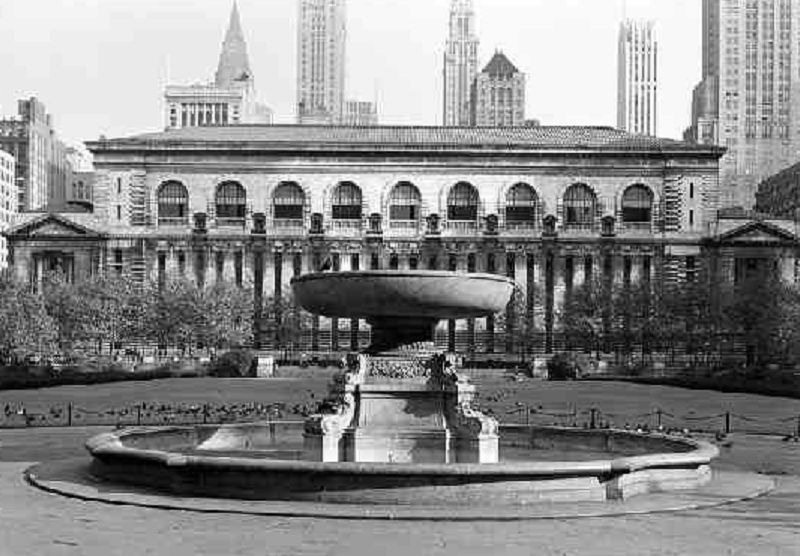
Before the New York Public Library was constructed, the land on which it sits was occupied by the Croton Reservoir, which was constructed in 1842. Adjacent to the reservoir was a public space, briefly known as Reservoir Square and then renamed Bryant Park in 1884 after poet, editor, and orator William Cullen Bryant. When Carrere & Hastings designed the New York Public Library, they included elements that harmonized with the neighboring park, but by the 1920s the park had been sorely neglected. In 1933, Queens architect Lusby Simpson won a competition to re-design Bryant Park, creating the contained and orderly open space that remains today. It was designated a scenic landmark in 1974.
The Parks Department says about the Lowell monument:
Architect Charles A. Platt (1861–1933) designed this elegant black granite ornamental fountain to commemorate social worker and reformer Josephine Shaw Lowell (1843–1905). Shaw, who is said to be the first woman to be honored by a major monument in New York City, was the first female member of the New York State Board of Charities, serving from 1876 to 1889.
The Memorial Committee that worked to build the fountain originally wanted it placed in Corlear’s Hook Park on Manhattan’s Lower East Side, near where Shaw focused her energies. Instead, the fountain, with its 32-foot-wide lower basin and 13-foot-wide upper basin, was ultimately installed at the east side of Bryant Park in 1913. In 1936 the fountain was moved to the west side of the park. The fountain was refurbished as part of an overall restoration of the park by the Bryant Park Restoration Corporation, completed in 1992.
Did you know that in 1853 New York City’s Crystal Palace was constructed on the site of Bryant Park for an international exhibition of the Industry of All Nations? The structure burned down in 1858.
Image via MCNY
Before the New York Public Library was constructed, the land on which it sits was occupied by the Croton Reservoir, which was constructed in 1842. Adjacent to the reservoir was a public space, briefly known as Reservoir Square and then renamed Bryant Park in 1884 after poet, editor, and orator William Cullen Bryant. When Carrere & Hastings designed the New York Public Library, they included elements that harmonized with the neighboring park, but by the 1920s the park had been sorely neglected. In 1933, Queens architect Lusby Simpson won a competition to re-design Bryant Park, creating the contained and orderly open space that remains today. It was designated a scenic landmark in 1974.
The Parks Department says about the Lowell monument:
Architect Charles A. Platt (1861–1933) designed this elegant black granite ornamental fountain to commemorate social worker and reformer Josephine Shaw Lowell (1843–1905). Shaw, who is said to be the first woman to be honored by a major monument in New York City, was the first female member of the New York State Board of Charities, serving from 1876 to 1889.
The Memorial Committee that worked to build the fountain originally wanted it placed in Corlear’s Hook Park on Manhattan’s Lower East Side, near where Shaw focused her energies. Instead, the fountain, with its 32-foot-wide lower basin and 13-foot-wide upper basin, was ultimately installed at the east side of Bryant Park in 1913. In 1936 the fountain was moved to the west side of the park. The fountain was refurbished as part of an overall restoration of the park by the Bryant Park Restoration Corporation, completed in 1992.
Did you know that in 1853 New York City’s Crystal Palace was constructed on the site of Bryant Park for an international exhibition of the Industry of All Nations? The structure burned down in 1858.
Image via MCNY
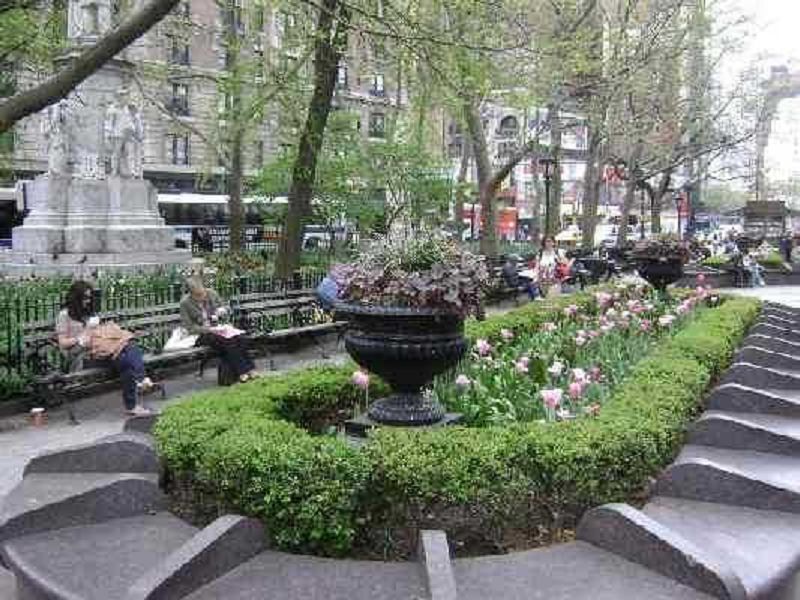
This small, triangular-shaped scenic landmark on the Upper West Side of Manhattan is named for a famous Italian opera composer. What is the scenic landmark's name?
Image via NYC Parks
Straus Park
Richard Tucker Park
Dante Park
Verdi Square
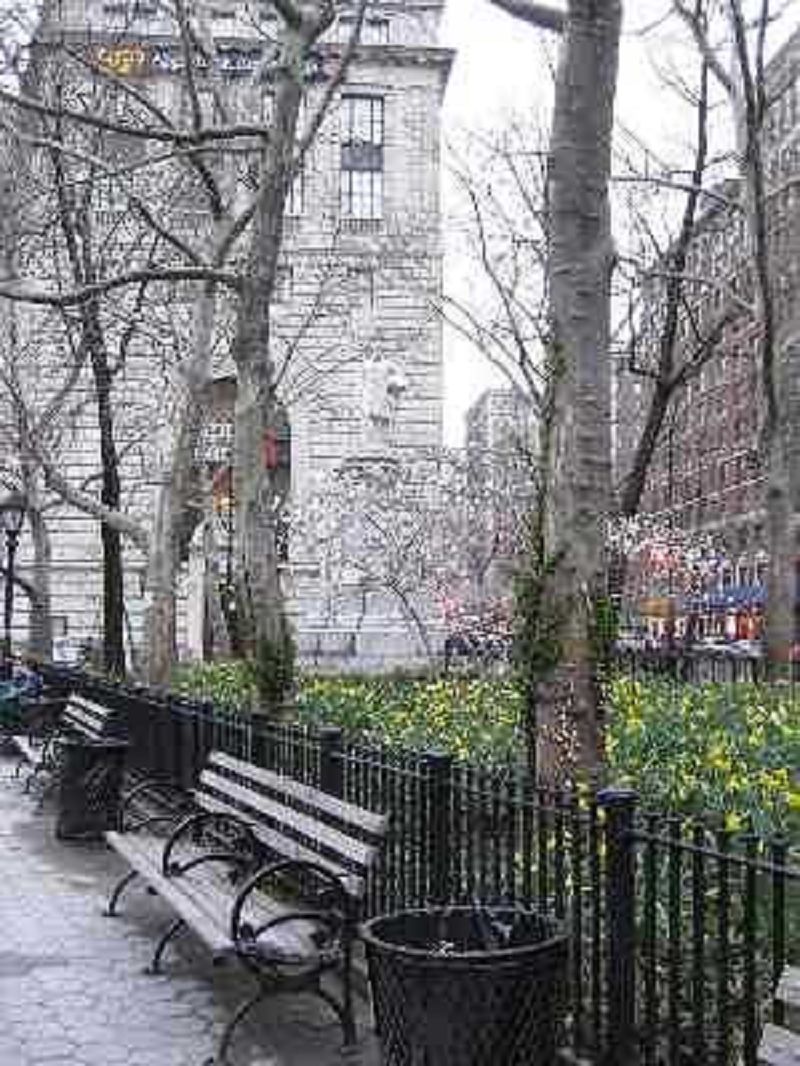
Verdi Square is a diminutive refuge at the intersection of Broadway, Amsterdam Avenue, and 73rd Street, with the monumental Central Savings Bank, an individual and interior landmark, as its northern backdrop. The memorial to Giuseppe Verdi, which was sponsored by Italian newspaper editor Charles Barsotti in honor of New York City’s Italian community, includes a Carrara marble sculpture of the composer by Pasquale Civiletti. Unveiled in 1906, the figure stands on a 15-foot-tall granite pedestal encircled by four life-size figures representing some of the leading characters from Verdi’s oeuvre, including Aida, Falstaff, Othello, and La Forza del Destino. Verdi Square, which is the city’s smallest scenic landmark, was designated in 1975.
Image via Wikimedia Commons user NewYorkDolls
Verdi Square is a diminutive refuge at the intersection of Broadway, Amsterdam Avenue, and 73rd Street, with the monumental Central Savings Bank, an individual and interior landmark, as its northern backdrop. The memorial to Giuseppe Verdi, which was sponsored by Italian newspaper editor Charles Barsotti in honor of New York City’s Italian community, includes a Carrara marble sculpture of the composer by Pasquale Civiletti. Unveiled in 1906, the figure stands on a 15-foot-tall granite pedestal encircled by four life-size figures representing some of the leading characters from Verdi’s oeuvre, including Aida, Falstaff, Othello, and La Forza del Destino. Verdi Square, which is the city’s smallest scenic landmark, was designated in 1975.
Image via Wikimedia Commons user NewYorkDolls
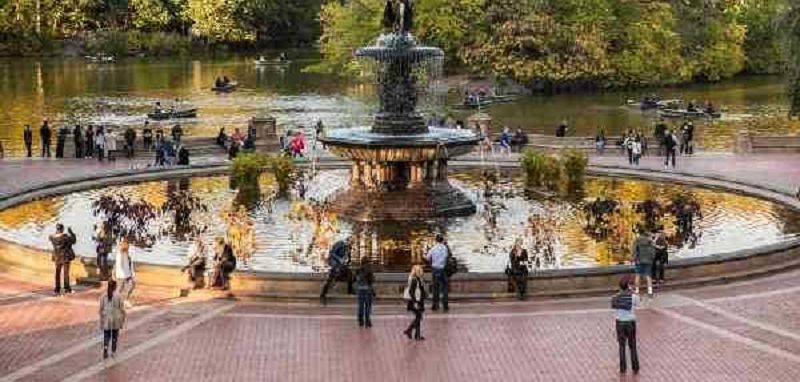
The Bethesda Fountain, located within the Central Park scenic landmark, is topped by a large bronze figure of what divine creature?
Image via NYC Go
A phoenix
A centaur
An angel
A griffin
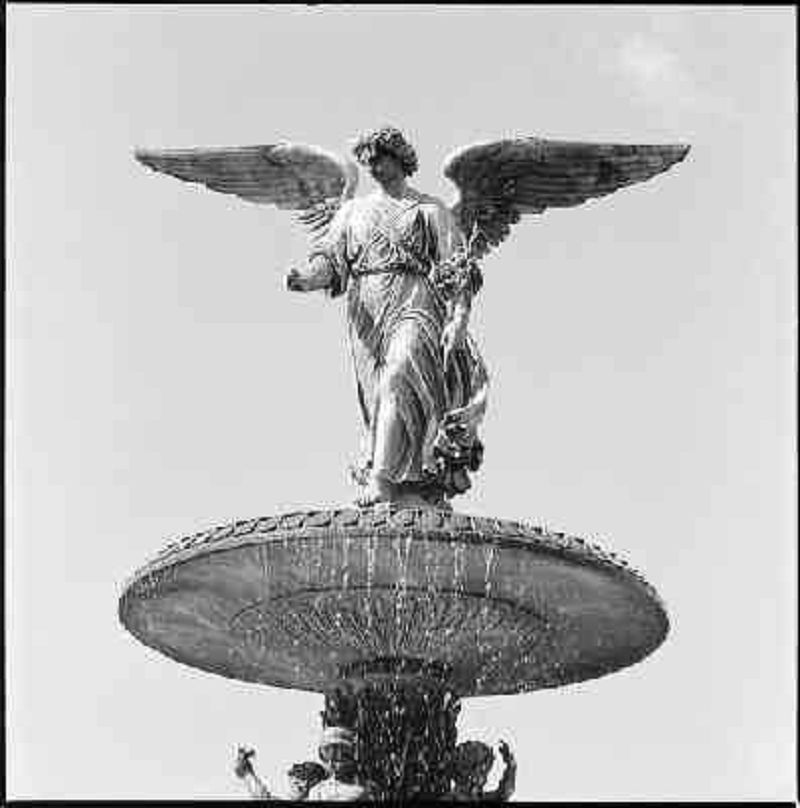
The Bethesda Fountain, created in the 1860s by Emma Stebbins, features an angel (the Angel of the Waters) in bronze, rising above a basin supported on a pedestal carved with four youthful figures representing Health, Purity, Temperance, and Peace. Central Park was designated a scenic landmark in 1974 and includes several dozen statues.
Did you know that the Angel of the Waters was the earliest public artwork by a woman in New York City?
Image via MCNY
The Bethesda Fountain, created in the 1860s by Emma Stebbins, features an angel (the Angel of the Waters) in bronze, rising above a basin supported on a pedestal carved with four youthful figures representing Health, Purity, Temperance, and Peace. Central Park was designated a scenic landmark in 1974 and includes several dozen statues.
Did you know that the Angel of the Waters was the earliest public artwork by a woman in New York City?
Image via MCNY
What parkway (and scenic landmark), named for its endpoint, stretches approximately six miles between Prospect Park and Coney Island?
Ocean Parkway
Eastern Parkway
Bay Ridge Parkway
Jackie Robinson Parkway

The concept for Ocean Parkway was first articulated by Frederick Law Olmsted and Calvert Vaux when they began their plans for Prospect Park. They proposed a picturesque and pleasant roadway lined by trees that would extend from the park to the ocean, coining the term “parkway” to describe their vision. The central promenade would be for leisurely rides while service roads on either side would allow access to the residences. Construction started on Ocean Parkway in 1874 and the route was opened to Coney Island in 1876. Featuring benches, playing tables, and a bicycle path, the parkway was designated a scenic landmark in 1975.
Image via MCNY
The concept for Ocean Parkway was first articulated by Frederick Law Olmsted and Calvert Vaux when they began their plans for Prospect Park. They proposed a picturesque and pleasant roadway lined by trees that would extend from the park to the ocean, coining the term “parkway” to describe their vision. The central promenade would be for leisurely rides while service roads on either side would allow access to the residences. Construction started on Ocean Parkway in 1874 and the route was opened to Coney Island in 1876. Featuring benches, playing tables, and a bicycle path, the parkway was designated a scenic landmark in 1975.
Image via MCNY
The Cleft Ridge Span, a bridge constructed in 1872 within the Prospect Park scenic landmark, is the first arch in the United States constructed of what material that decades later would become ubiquitous in modern architecture?
Plastic
Chrome
Concrete
Glass
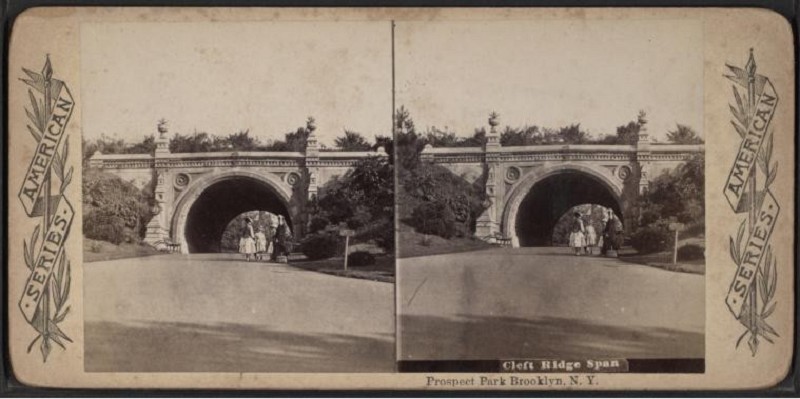
The Cleft Ridge Span carries a roadway within Prospect Park, which was designated a scenic landmark in 1975. Below the span, the intricately patterned barrel archway shelters a pedestrian path. Constructed in 1871-72, the structure was built using cast concrete produced by the New York and Long Island Coignet Stone Company, one of the first firms in the country to industrialize the production of concrete. The material could be cast into ornate patterns quickly and cheaply, making it an appealing option for Frederick Law Olmsted and Calvert Vaux when they were designing Prospect Park. In addition to the Cleft Ridge Span, the company also constructed a new office in 1872 built entirely of Coignet stone to showcase its versatility. The New York & Long Island Coignet Stone Company Building is considered the earliest known concrete building in New York City and was designated an individual landmark in 2012.
Image via NYPL
The Cleft Ridge Span carries a roadway within Prospect Park, which was designated a scenic landmark in 1975. Below the span, the intricately patterned barrel archway shelters a pedestrian path. Constructed in 1871-72, the structure was built using cast concrete produced by the New York and Long Island Coignet Stone Company, one of the first firms in the country to industrialize the production of concrete. The material could be cast into ornate patterns quickly and cheaply, making it an appealing option for Frederick Law Olmsted and Calvert Vaux when they were designing Prospect Park. In addition to the Cleft Ridge Span, the company also constructed a new office in 1872 built entirely of Coignet stone to showcase its versatility. The New York & Long Island Coignet Stone Company Building is considered the earliest known concrete building in New York City and was designated an individual landmark in 2012.
Image via NYPL
Eastern Parkway begins in front of which individual landmark in Brooklyn?
Central Library, Brooklyn Public Library
Litchfield Villa
Bureau of Fire Communications
Brooklyn Borough Hall

Constructed in 1935-41, Brooklyn’s Central Library is located at the west entrance to Eastern Parkway, a scenic landmark. Designed by Frederick Law Olmsted and Calvert Vaux, this influential tree-lined, multi-lane “parkway” extends 2.2 miles, ending in East New York at Ralph Avenue.
Did you know that the designers hoped the parkway would become part of a larger regional system, continuing north to the East River and even Central Park?
Image via MCNY
Constructed in 1935-41, Brooklyn’s Central Library is located at the west entrance to Eastern Parkway, a scenic landmark. Designed by Frederick Law Olmsted and Calvert Vaux, this influential tree-lined, multi-lane “parkway” extends 2.2 miles, ending in East New York at Ralph Avenue.
Did you know that the designers hoped the parkway would become part of a larger regional system, continuing north to the East River and even Central Park?
Image via MCNY
Which First Lady has a monument in a scenic landmark?
Mary Todd Lincoln
Martha Washington
Eleanor Roosevelt
Lady Bird Johnson
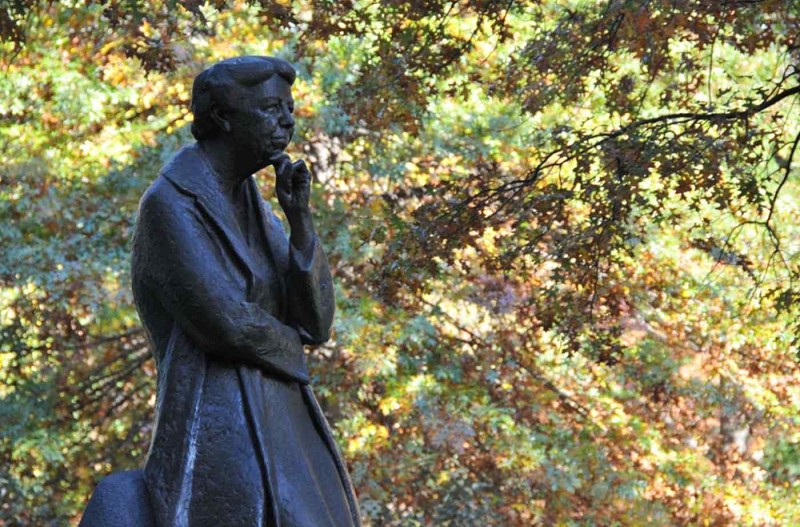
A bronze statue of New York City-born Eleanor Roosevelt stands in Riverside Park, near 72nd Street. Riverside Park and Riverside Drive were designated a scenic landmark in 1980. Penelope Jenks sculpted the eight-foot-tall figure, which was dedicated by First Lady Hillary Rodham Clinton in October 1996.
Image via NYC Parks
A bronze statue of New York City-born Eleanor Roosevelt stands in Riverside Park, near 72nd Street. Riverside Park and Riverside Drive were designated a scenic landmark in 1980. Penelope Jenks sculpted the eight-foot-tall figure, which was dedicated by First Lady Hillary Rodham Clinton in October 1996.
Image via NYC Parks
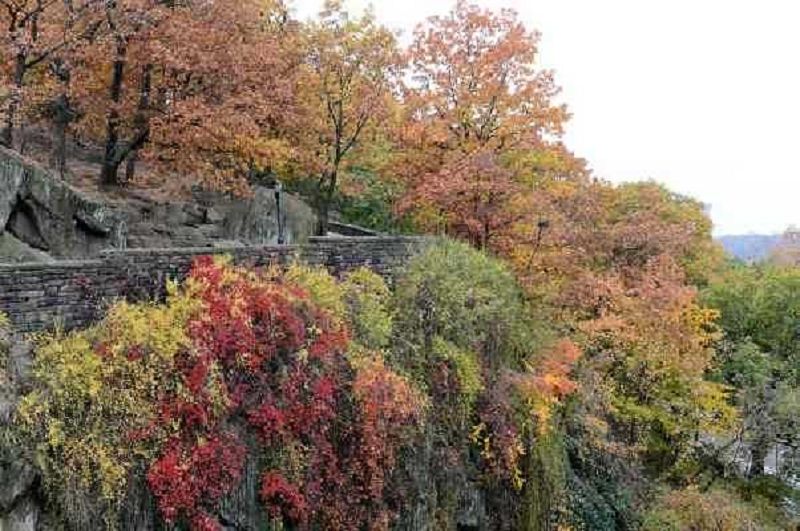
Which scenic landmark was donated to NYC by John D. Rockefeller and contains an important art museum?
Image via NYC Parks
Riverside Park
Fort Tryon Park
Central Park
Prospect Park

Overlooking the magnificent Hudson River in the Inwood section of Manhattan, John D. Rockefeller Jr. Began assembling the site for Fort Tryon Park in 1917. Construction of the 67-acre park took about five years, from 1930 to 1935. The landscape architect was Olmsted Brothers, the successor firm to the one founded earlier by Frederick Law Olmsted, who co-designed Central, Prospect, and Riverside Parks, all also scenic landmarks.
Fort Tryon Park contains The Cloisters, also an individual landmark and part of the Metropolitan Museum of Art. Opened in 1938, the neo-French Romanesque structure by architect Charles Collens incorporates architectural fragments from various European cloisters and other medieval buildings.
Did you know that many of the museum’s treasures were purchased in 1924 from an American sculptor, who named his installation of medieval art George Grey Barnard’s Cloisters?
Image of The Cloisters via Will Steacy/NYC Mayor's Office
Overlooking the magnificent Hudson River in the Inwood section of Manhattan, John D. Rockefeller Jr. Began assembling the site for Fort Tryon Park in 1917. Construction of the 67-acre park took about five years, from 1930 to 1935. The landscape architect was Olmsted Brothers, the successor firm to the one founded earlier by Frederick Law Olmsted, who co-designed Central, Prospect, and Riverside Parks, all also scenic landmarks.
Fort Tryon Park contains The Cloisters, also an individual landmark and part of the Metropolitan Museum of Art. Opened in 1938, the neo-French Romanesque structure by architect Charles Collens incorporates architectural fragments from various European cloisters and other medieval buildings.
Did you know that many of the museum’s treasures were purchased in 1924 from an American sculptor, who named his installation of medieval art George Grey Barnard’s Cloisters?
Image of The Cloisters via Will Steacy/NYC Mayor's Office
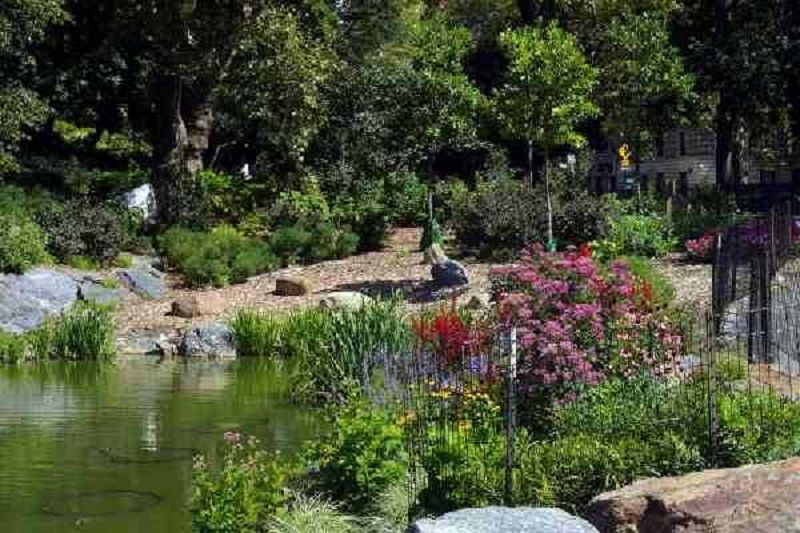
Manhattanville and Hamilton Heights
Sugar Hill and Morningside Heights
Upper West Side and Morningside Heights
Morningside Heights and Harlem

Thirteen craggy blocks long, Morningside Park is located between Morningside Heights and Harlem. Designated a scenic landmark in 2008, it stretches from 110th Street to 123rd Street. First proposed in 1867, the landscaping was mostly completed by 1895.
Did you know that this 30-acre park has many impressive works of art, including a bronze statue of Lafayette and Washington by Frederic Auguste Bartholdi, sculptor of the Statue of Liberty?
Image via MCNY
Thirteen craggy blocks long, Morningside Park is located between Morningside Heights and Harlem. Designated a scenic landmark in 2008, it stretches from 110th Street to 123rd Street. First proposed in 1867, the landscaping was mostly completed by 1895.
Did you know that this 30-acre park has many impressive works of art, including a bronze statue of Lafayette and Washington by Frederic Auguste Bartholdi, sculptor of the Statue of Liberty?
Image via MCNY
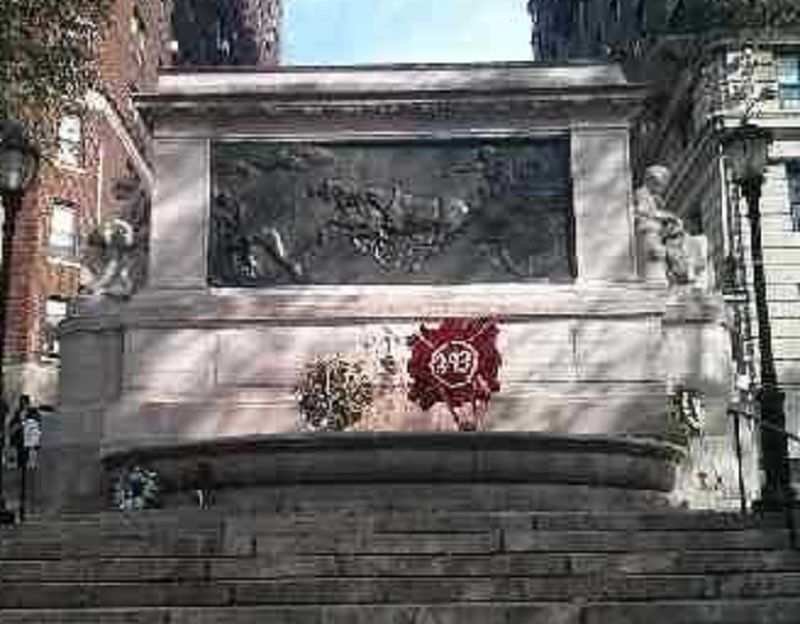
"New York’s bravest” are remembered with a memorial in which scenic landmark?
Image via Wikimedia Commons user Pburka
Prospect Park
Morningside Park
Riverside Park and Riverside Drive
Grand Army Plaza
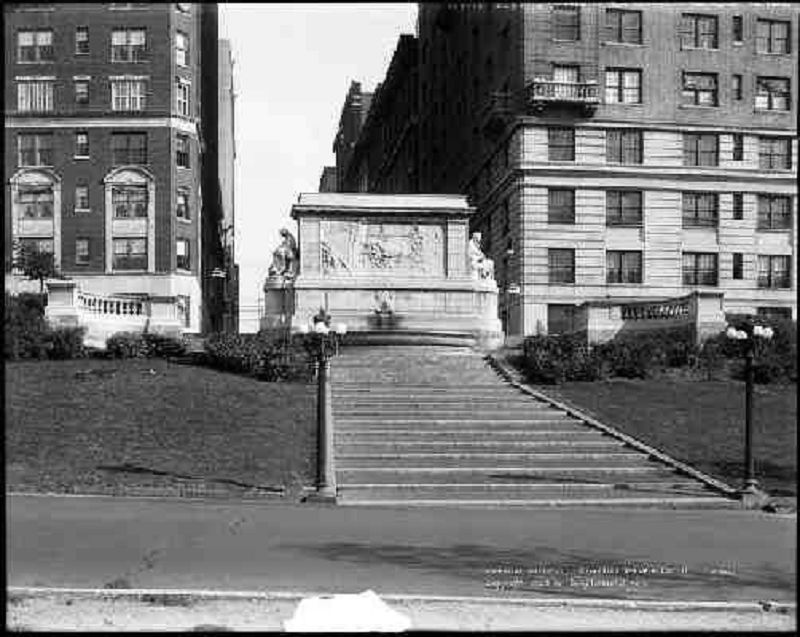
The Firemen’s Memorial is located at Riverside Drive and 100th Street in the Riverside Park and Riverside Drive scenic landmark. Dedicated in 1913, the marble figures (Sacrifice and Duty) and bronze reliefs are by sculptor Attilio Piccirlli, who also produced prominent artworks for Rockefeller Center and Central Park. The monument, stairs and plaza were designed by architect Harold Van Buren Magonigle.
Image via MCNY
The Firemen’s Memorial is located at Riverside Drive and 100th Street in the Riverside Park and Riverside Drive scenic landmark. Dedicated in 1913, the marble figures (Sacrifice and Duty) and bronze reliefs are by sculptor Attilio Piccirlli, who also produced prominent artworks for Rockefeller Center and Central Park. The monument, stairs and plaza were designed by architect Harold Van Buren Magonigle.
Image via MCNY
{"name":"How Well Do You Know New York City's Scenic Landmarks?", "url":"https://www.quiz-maker.com/QPREVIEW","txt":"How well do you know New York City's eleven scenic landmarks? Take this quiz to find out!","img":"https://cdn.poll-maker.com/52-1967899/centralpark-christopherpostlewaite-0671-40.jpg?sz=1200-00000018541000005300","accounts":"@nyclandmarks","hash":"#LoveNYCLandmarks"}